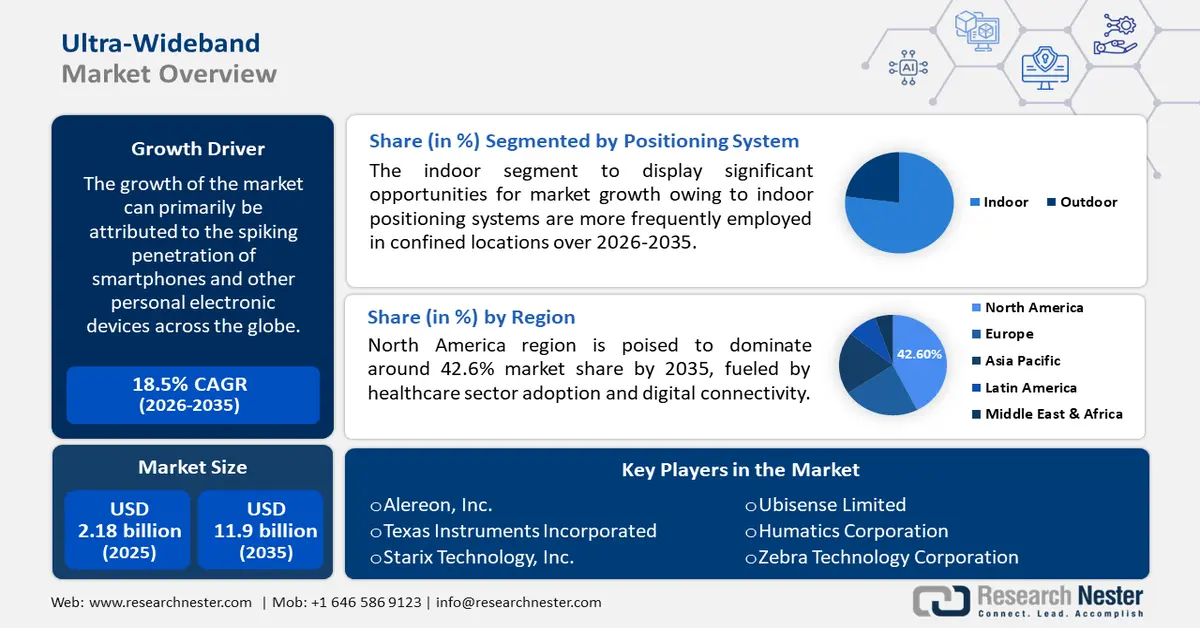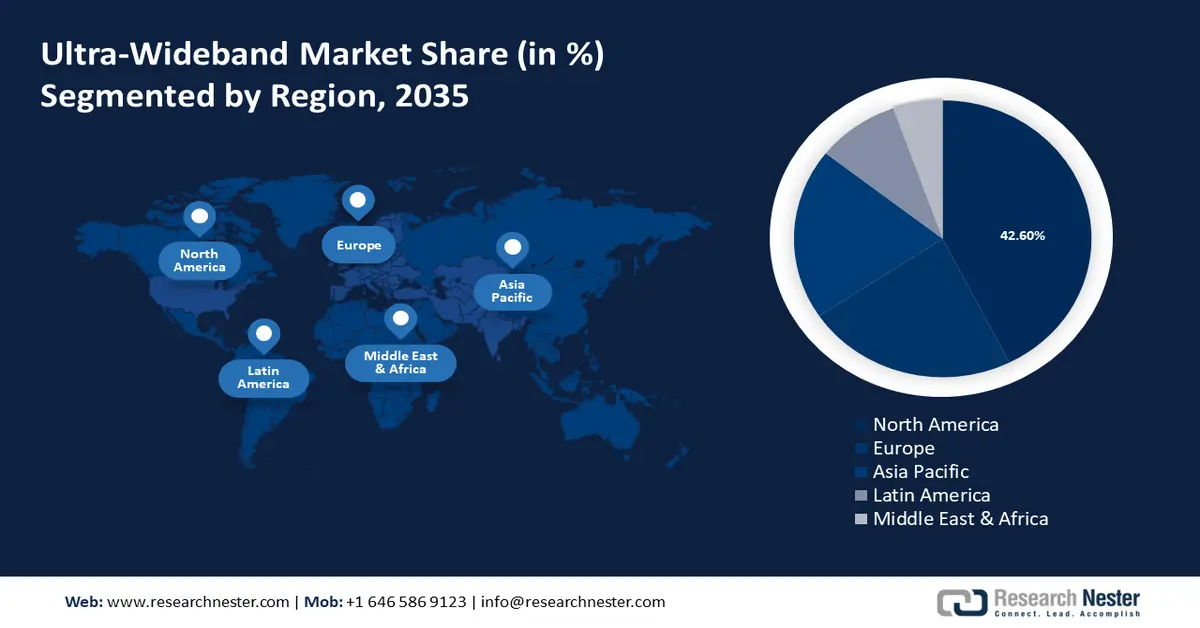
限時節慶優惠 | 超寬頻 市場報告 @ $2450
超寬頻市場展望:
2025年超寬頻市場規模超過21.8億美元,預計到2035年將達到119億美元,預測期內(即2026-2035年)的複合年增長率約為18.5%。 2026年,超寬頻產業規模估計為25.4億美元。

市場成長可歸因於全球智慧型手機和其他個人電子設備的迅猛普及。超寬頻 (UWB) 技術在內部導航和位置追蹤方面特別精確,使其成為智慧型手機等消費性電子產品的有效解決方案。智慧型手機和其他便攜式電子設備正迅速用於執行需要低延遲無線連接的高頻寬應用,例如觀看線上影片和玩遊戲。例如,據估計,2018 年全球智慧型手機用戶數量達到約 50 億,預計到 2027 年將達到約 70 億。
此外,IT產業的大幅擴張和無線感測器網路的日益普及也將影響市場規模。例如,2022年,全球IT產業在電信方面的支出約為1兆美元,預計這一數字還會上升。此外,隨著網路用戶數量的增加,行動數據流量的激增預計將推動市場成長。
關鍵 超寬頻 市場洞察摘要:
區域亮點:
- 受醫療保健行業採用和數位連接推動,到 2035 年,北美超寬頻市場將佔據超過 42.6% 的市場份額。
細分市場洞察:
- 預計到 2035 年,超寬頻市場中的室內細分市場將佔據主導地位,佔據相當大的份額,這得益於 UWB 提供精確室內定位的能力。
- 預計在 2026 年至 2035 年期間,超寬頻市場中的即時定位 (RTL) 細分市場將經歷顯著增長,這主要得益於醫療保健和其他行業對即時定位服務的日益普及。
主要成長趨勢:
- 醫療保健產業對超寬頻的需求不斷增長
- 全球物聯網滲透率不斷提升
主要挑戰:
- 過氧乙酸的高反應性所帶來的威脅
- 缺乏對過氧乙酸各種影響的認知
主要參與者:Johanson Technology Inc.、Alereon, Inc.、德州儀器公司、Starix Technology, Inc.、NXP Semiconductors N.V.、Ubisense Limited、Humatics Corporation、Zebra Technology Corporation、Apple Inc.、5D Robotics, Inc.
全球 超寬頻 市場 預測與區域展望:
市場規模與成長預測:
- 2025年市場規模: 21.8億美元
- 2026年市場規模: 25.4億美元
- 預計市場規模:到 2035 年將達到 119 億美元
- 成長預測:複合年增長率18.5%(2026-2035)
主要區域動態:
- 最大的地區:北美(到 2035 年佔 42.6%)
- 成長最快的地區:亞太地區
- 主要國家:美國、中國、韓國、日本、德國
- 新興國家:中國、印度、日本、韓國、巴西
Last updated on : 8 September, 2025
超寬頻市場的成長動力與挑戰:
成長動力
- 醫療保健領域對超寬頻的需求不斷增長——截至2019年,全球人均醫療支出估計約為1,100美元。超寬頻在醫療保健領域意義重大,因為它能夠有效地促進醫療監測。此外,超寬頻還可用於監測患者的運動,透過發射無線射頻波來確定人體內部的重要徵兆。此外,該技術還有助於監測和分析藥品儲存,以進行品質測量。因此,預計在預測期內,如此高的需求將推動超寬頻市場的成長。
- 全球物聯網滲透率不斷提升—物聯網 (IoT)的全球應用日益普及,這推動了超寬頻 (UWB) 產業的擴張。此外,由於 UWB 技術功耗低、傳輸距離短、頻寬大,非常適合依賴無線通訊發送和接收資料的物聯網設備。預計 2020 年全球物聯網總支出將達到約 7,000 億美元,並將持續維持年增。
- 消費者在電子產品上的支出不斷增加-預計 2022 年全球消費性電子產品支出約為 5,000 億美元,而同年全球設備總出貨量預計將達到約 20 億台。
- 超寬頻在零售業的廣泛應用—零售業是利用超寬頻的主要產業之一。超寬頻技術尤其適用於室內定位,可即時追蹤商品和購物車等資產。這可以幫助商家更好地控制庫存、減少損耗並改善客戶服務。據觀察,2020年全球零售業總銷售額達約22兆美元,預計2025年將進一步增至近30兆美元。
挑戰
- UWB 通訊通道估計的複雜性-通道估計值是設計無線通訊接收器時的重要參數。 UWB 中更大的頻段可能會加速天線更換,並使天線數量複雜化,從而進一步增加通道估計的複雜性。因此,預計此類複雜性將在預測期內阻礙市場的成長。
- 欠發達地區認知度較低
- 持續需要昂貴的維護
超寬頻市場規模及預測:
| 報告屬性 | 詳細資訊 |
|---|---|
|
基準年 |
2025 |
|
預測期 |
2026-2035 |
|
複合年增長率 |
18.5% |
|
基準年市場規模(2025年) |
21.8億美元 |
|
預測年度市場規模(2035年) |
119億美元 |
|
區域範圍 |
|
超寬頻市場細分:
定位系統細分分析
預計到2035年底,室內定位市場將佔據主導地位。由於典型的GPS訊號在建築物等狹窄空間內可能較弱或受阻,因此室內定位系統在這些環境中的應用更為廣泛。 UWB憑藉其高頻寬和低功耗的特性,非常適合此類應用,即使在多路徑幹擾嚴重的環境中,它也能利用飛行時間(ToF)測量提供精確的位置資料。 UWB的應用包括資產追蹤、室內導航和緊急應變等。例如,根據報告數據,UWB技術的精度遠高於Wi-Fi或藍牙等其他無線技術,精度可達10-35公分。
應用細分分析
由於全球多個行業即時定位服務的蓬勃發展,預計即時定位系統 (RTLS) 細分市場在預測期內將顯著成長。此外,它有助於確定醫療保健領域特定設備和患者的位置,預計將推動該細分市場的成長。例如,到 2022 年,預計全球公共場所、智慧辦公室、飯店、醫療保健、製造業等各垂直產業的藍牙即時定位服務應用率將達到 58% 左右。
我們對全球市場的深入分析包括以下幾個部分:
按定位系統 |
|
按應用 |
|
按最終用戶 |
|

Vishnu Nair
全球業務發展主管根據您的需求自訂本報告 — 與我們的顧問聯繫,獲得個人化的洞察與選項。
超寬頻市場區域分析:
北美市場洞察
到2035年,北美地區預計將佔據約42.6%的市場。市場成長可能得益於醫療保健產業的持續發展以及該地區主要參與者的參與。在醫療保健領域,患者需要從一個房間移動到另一個房間,而超寬頻技術可以追蹤患者的位置,這反過來有望進一步提升市場收入。此外,數據通訊需求不斷增長,隨之而來的是數位人口的不斷增長,預計這將推動北美地區市場的成長。數據顯示,超過90%的美國人口已達到數位互聯。

超寬頻市場參與者:
- 約翰遜科技公司
- 公司概況
- 商業策略
- 主要產品
- 財務表現
- 關鍵績效指標
- 風險分析
- 近期發展
- 區域影響力
- SWOT分析
- Alereon公司
- 德州儀器公司
- Starix科技公司
- 恩智浦半導體公司
- 宇信有限公司
- 人類公司
- 斑馬技術公司
- 蘋果公司
- 5D機器人公司
最新動態
德州儀器公司 (TI) 宣布推出全新藍牙低功耗 (BLE) 無線 MCU 系列,進一步擴展其連接產品組合。該系統旨在以低於其他設備的價格提供高品質的低功耗藍牙連接。
Ubisense Limited推出其全新 UB-Tag,該標籤配備同步超寬頻和低功耗藍牙 (BLE) 追蹤功能。 UB-Tag 堅固耐用、體積小巧,適用於工業應用。本裝置可同時傳輸低功耗藍牙和超寬頻訊號。
- Report ID: 3321
- Published Date: Sep 08, 2025
- Report Format: PDF, PPT
- 探索关键市场趋势和洞察的预览
- 查看样本数据表和细分分析
- 体验我们可视化数据呈现的质量
- 评估我们的报告结构和研究方法
- 一窥竞争格局分析
- 了解区域预测的呈现方式
- 评估公司概况与基准分析的深度
- 预览可执行洞察如何支持您的战略
探索真实数据和分析
常见问题 (FAQ)
See how top U.S. companies are managing market uncertainty — get your free sample with trends, challenges, macroeconomic factors, charts, forecasts, and more.
版权所有 © 2026 Research Nester。保留所有权利。




 Afghanistan (+93)
Afghanistan (+93)
 Åland Islands (+358)
Åland Islands (+358)
 Albania (+355)
Albania (+355)
 Algeria (+213)
Algeria (+213)
 American Samoa (+1684)
American Samoa (+1684)
 Andorra (+376)
Andorra (+376)
 Angola (+244)
Angola (+244)
 Anguilla (+1264)
Anguilla (+1264)
 Antarctica (+672)
Antarctica (+672)
 Antigua and Barbuda (+1268)
Antigua and Barbuda (+1268)
 Argentina (+54)
Argentina (+54)
 Armenia (+374)
Armenia (+374)
 Aruba (+297)
Aruba (+297)
 Australia (+61)
Australia (+61)
 Austria (+43)
Austria (+43)
 Azerbaijan (+994)
Azerbaijan (+994)
 Bahamas (+1242)
Bahamas (+1242)
 Bahrain (+973)
Bahrain (+973)
 Bangladesh (+880)
Bangladesh (+880)
 Barbados (+1246)
Barbados (+1246)
 Belarus (+375)
Belarus (+375)
 Belgium (+32)
Belgium (+32)
 Belize (+501)
Belize (+501)
 Benin (+229)
Benin (+229)
 Bermuda (+1441)
Bermuda (+1441)
 Bhutan (+975)
Bhutan (+975)
 Bolivia (+591)
Bolivia (+591)
 Bosnia and Herzegovina (+387)
Bosnia and Herzegovina (+387)
 Botswana (+267)
Botswana (+267)
 Bouvet Island (+)
Bouvet Island (+)
 Brazil (+55)
Brazil (+55)
 British Indian Ocean Territory (+246)
British Indian Ocean Territory (+246)
 British Virgin Islands (+1284)
British Virgin Islands (+1284)
 Brunei (+673)
Brunei (+673)
 Bulgaria (+359)
Bulgaria (+359)
 Burkina Faso (+226)
Burkina Faso (+226)
 Burundi (+257)
Burundi (+257)
 Cambodia (+855)
Cambodia (+855)
 Cameroon (+237)
Cameroon (+237)
 Canada (+1)
Canada (+1)
 Cape Verde (+238)
Cape Verde (+238)
 Cayman Islands (+1345)
Cayman Islands (+1345)
 Central African Republic (+236)
Central African Republic (+236)
 Chad (+235)
Chad (+235)
 Chile (+56)
Chile (+56)
 China (+86)
China (+86)
 Christmas Island (+61)
Christmas Island (+61)
 Cocos (Keeling) Islands (+61)
Cocos (Keeling) Islands (+61)
 Colombia (+57)
Colombia (+57)
 Comoros (+269)
Comoros (+269)
 Cook Islands (+682)
Cook Islands (+682)
 Costa Rica (+506)
Costa Rica (+506)
 Croatia (+385)
Croatia (+385)
 Cuba (+53)
Cuba (+53)
 Curaçao (+599)
Curaçao (+599)
 Cyprus (+357)
Cyprus (+357)
 Czechia (+420)
Czechia (+420)
 Democratic Republic of the Congo (+243)
Democratic Republic of the Congo (+243)
 Denmark (+45)
Denmark (+45)
 Djibouti (+253)
Djibouti (+253)
 Dominica (+1767)
Dominica (+1767)
 Dominican Republic (+1809)
Dominican Republic (+1809)
 Timor-Leste (+670)
Timor-Leste (+670)
 Ecuador (+593)
Ecuador (+593)
 Egypt (+20)
Egypt (+20)
 El Salvador (+503)
El Salvador (+503)
 Equatorial Guinea (+240)
Equatorial Guinea (+240)
 Eritrea (+291)
Eritrea (+291)
 Estonia (+372)
Estonia (+372)
 Ethiopia (+251)
Ethiopia (+251)
 Falkland Islands (+500)
Falkland Islands (+500)
 Faroe Islands (+298)
Faroe Islands (+298)
 Fiji (+679)
Fiji (+679)
 Finland (+358)
Finland (+358)
 France (+33)
France (+33)
 Gabon (+241)
Gabon (+241)
 Gambia (+220)
Gambia (+220)
 Georgia (+995)
Georgia (+995)
 Germany (+49)
Germany (+49)
 Ghana (+233)
Ghana (+233)
 Gibraltar (+350)
Gibraltar (+350)
 Greece (+30)
Greece (+30)
 Greenland (+299)
Greenland (+299)
 Grenada (+1473)
Grenada (+1473)
 Guadeloupe (+590)
Guadeloupe (+590)
 Guam (+1671)
Guam (+1671)
 Guatemala (+502)
Guatemala (+502)
 Guinea (+224)
Guinea (+224)
 Guinea-Bissau (+245)
Guinea-Bissau (+245)
 Guyana (+592)
Guyana (+592)
 Haiti (+509)
Haiti (+509)
 Honduras (+504)
Honduras (+504)
 Hong Kong (+852)
Hong Kong (+852)
 Hungary (+36)
Hungary (+36)
 Iceland (+354)
Iceland (+354)
 India (+91)
India (+91)
 Indonesia (+62)
Indonesia (+62)
 Iran (+98)
Iran (+98)
 Iraq (+964)
Iraq (+964)
 Ireland (+353)
Ireland (+353)
 Isle of Man (+44)
Isle of Man (+44)
 Israel (+972)
Israel (+972)
 Italy (+39)
Italy (+39)
 Jamaica (+1876)
Jamaica (+1876)
 Japan (+81)
Japan (+81)
 Jersey (+44)
Jersey (+44)
 Jordan (+962)
Jordan (+962)
 Kazakhstan (+7)
Kazakhstan (+7)
 Kenya (+254)
Kenya (+254)
 Kiribati (+686)
Kiribati (+686)
 Kuwait (+965)
Kuwait (+965)
 Kyrgyzstan (+996)
Kyrgyzstan (+996)
 Laos (+856)
Laos (+856)
 Latvia (+371)
Latvia (+371)
 Lebanon (+961)
Lebanon (+961)
 Lesotho (+266)
Lesotho (+266)
 Liberia (+231)
Liberia (+231)
 Libya (+218)
Libya (+218)
 Liechtenstein (+423)
Liechtenstein (+423)
 Lithuania (+370)
Lithuania (+370)
 Luxembourg (+352)
Luxembourg (+352)
 Macao (+853)
Macao (+853)
 Madagascar (+261)
Madagascar (+261)
 Malawi (+265)
Malawi (+265)
 Malaysia (+60)
Malaysia (+60)
 Maldives (+960)
Maldives (+960)
 Mali (+223)
Mali (+223)
 Malta (+356)
Malta (+356)
 Marshall Islands (+692)
Marshall Islands (+692)
 Mauritania (+222)
Mauritania (+222)
 Mauritius (+230)
Mauritius (+230)
 Mayotte (+262)
Mayotte (+262)
 Mexico (+52)
Mexico (+52)
 Micronesia (+691)
Micronesia (+691)
 Moldova (+373)
Moldova (+373)
 Monaco (+377)
Monaco (+377)
 Mongolia (+976)
Mongolia (+976)
 Montenegro (+382)
Montenegro (+382)
 Montserrat (+1664)
Montserrat (+1664)
 Morocco (+212)
Morocco (+212)
 Mozambique (+258)
Mozambique (+258)
 Myanmar (+95)
Myanmar (+95)
 Namibia (+264)
Namibia (+264)
 Nauru (+674)
Nauru (+674)
 Nepal (+977)
Nepal (+977)
 Netherlands (+31)
Netherlands (+31)
 New Caledonia (+687)
New Caledonia (+687)
 New Zealand (+64)
New Zealand (+64)
 Nicaragua (+505)
Nicaragua (+505)
 Niger (+227)
Niger (+227)
 Nigeria (+234)
Nigeria (+234)
 Niue (+683)
Niue (+683)
 Norfolk Island (+672)
Norfolk Island (+672)
 North Korea (+850)
North Korea (+850)
 Northern Mariana Islands (+1670)
Northern Mariana Islands (+1670)
 Norway (+47)
Norway (+47)
 Oman (+968)
Oman (+968)
 Pakistan (+92)
Pakistan (+92)
 Palau (+680)
Palau (+680)
 Palestine (+970)
Palestine (+970)
 Panama (+507)
Panama (+507)
 Papua New Guinea (+675)
Papua New Guinea (+675)
 Paraguay (+595)
Paraguay (+595)
 Peru (+51)
Peru (+51)
 Philippines (+63)
Philippines (+63)
 Poland (+48)
Poland (+48)
 Portugal (+351)
Portugal (+351)
 Puerto Rico (+1787)
Puerto Rico (+1787)
 Qatar (+974)
Qatar (+974)
 Romania (+40)
Romania (+40)
 Russia (+7)
Russia (+7)
 Rwanda (+250)
Rwanda (+250)
 Saint Barthélemy (+590)
Saint Barthélemy (+590)
 Saint Helena, Ascension and Tristan da Cunha (+290)
Saint Helena, Ascension and Tristan da Cunha (+290)
 Saint Kitts and Nevis (+1869)
Saint Kitts and Nevis (+1869)
 Saint Lucia (+1758)
Saint Lucia (+1758)
 Saint Martin (French part) (+590)
Saint Martin (French part) (+590)
 Saint Pierre and Miquelon (+508)
Saint Pierre and Miquelon (+508)
 Saint Vincent and the Grenadines (+1784)
Saint Vincent and the Grenadines (+1784)
 Samoa (+685)
Samoa (+685)
 San Marino (+378)
San Marino (+378)
 Sao Tome and Principe (+239)
Sao Tome and Principe (+239)
 Saudi Arabia (+966)
Saudi Arabia (+966)
 Senegal (+221)
Senegal (+221)
 Serbia (+381)
Serbia (+381)
 Seychelles (+248)
Seychelles (+248)
 Sierra Leone (+232)
Sierra Leone (+232)
 Singapore (+65)
Singapore (+65)
 Sint Maarten (Dutch part) (+1721)
Sint Maarten (Dutch part) (+1721)
 Slovakia (+421)
Slovakia (+421)
 Slovenia (+386)
Slovenia (+386)
 Solomon Islands (+677)
Solomon Islands (+677)
 Somalia (+252)
Somalia (+252)
 South Africa (+27)
South Africa (+27)
 South Georgia and the South Sandwich Islands (+0)
South Georgia and the South Sandwich Islands (+0)
 South Korea (+82)
South Korea (+82)
 South Sudan (+211)
South Sudan (+211)
 Spain (+34)
Spain (+34)
 Sri Lanka (+94)
Sri Lanka (+94)
 Sudan (+249)
Sudan (+249)
 Suriname (+597)
Suriname (+597)
 Svalbard and Jan Mayen (+47)
Svalbard and Jan Mayen (+47)
 Eswatini (+268)
Eswatini (+268)
 Sweden (+46)
Sweden (+46)
 Switzerland (+41)
Switzerland (+41)
 Syria (+963)
Syria (+963)
 Taiwan (+886)
Taiwan (+886)
 Tajikistan (+992)
Tajikistan (+992)
 Tanzania (+255)
Tanzania (+255)
 Thailand (+66)
Thailand (+66)
 Togo (+228)
Togo (+228)
 Tokelau (+690)
Tokelau (+690)
 Tonga (+676)
Tonga (+676)
 Trinidad and Tobago (+1868)
Trinidad and Tobago (+1868)
 Tunisia (+216)
Tunisia (+216)
 Turkey (+90)
Turkey (+90)
 Turkmenistan (+993)
Turkmenistan (+993)
 Turks and Caicos Islands (+1649)
Turks and Caicos Islands (+1649)
 Tuvalu (+688)
Tuvalu (+688)
 Uganda (+256)
Uganda (+256)
 Ukraine (+380)
Ukraine (+380)
 United Arab Emirates (+971)
United Arab Emirates (+971)
 United Kingdom (+44)
United Kingdom (+44)
 Uruguay (+598)
Uruguay (+598)
 Uzbekistan (+998)
Uzbekistan (+998)
 Vanuatu (+678)
Vanuatu (+678)
 Vatican City (+39)
Vatican City (+39)
 Venezuela (Bolivarian Republic of) (+58)
Venezuela (Bolivarian Republic of) (+58)
 Vietnam (+84)
Vietnam (+84)
 Wallis and Futuna (+681)
Wallis and Futuna (+681)
 Western Sahara (+212)
Western Sahara (+212)
 Yemen (+967)
Yemen (+967)
 Zambia (+260)
Zambia (+260)
 Zimbabwe (+263)
Zimbabwe (+263)
